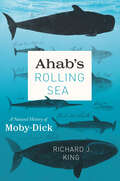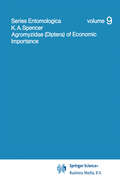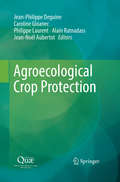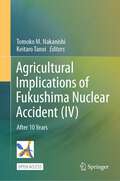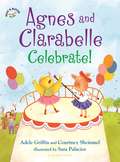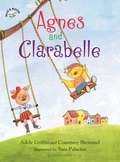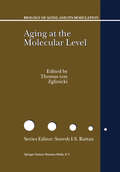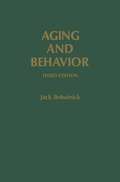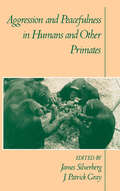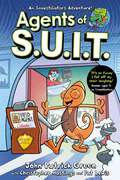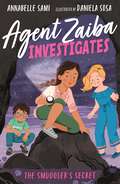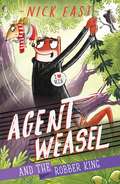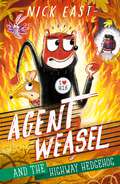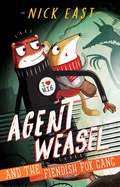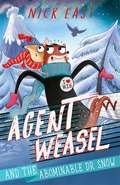- Table View
- List View
Ahab's Rolling Sea: A Natural History of "Moby-Dick"
by Richard J. KingAlthough Herman Melville’s Moby-Dick is beloved as one of the most profound and enduring works of American fiction, we rarely consider it a work of nature writing—or even a novel of the sea. Yet Pulitzer Prize–winning author Annie Dillard avers Moby-Dick is the “best book ever written about nature,” and nearly the entirety of the story is set on the waves, with scarcely a whiff of land. In fact, Ishmael’s sea yarn is in conversation with the nature writing of Emerson and Thoreau, and Melville himself did much more than live for a year in a cabin beside a pond. He set sail: to the far remote Pacific Ocean, spending more than three years at sea before writing his masterpiece in 1851. A revelation for Moby-Dick devotees and neophytes alike, Ahab’s Rolling Sea is a chronological journey through the natural history of Melville’s novel. From white whales to whale intelligence, giant squids, barnacles, albatross, and sharks, Richard J. King examines what Melville knew from his own experiences and the sources available to a reader in the mid-1800s, exploring how and why Melville might have twisted what was known to serve his fiction. King then climbs to the crow’s nest, setting Melville in the context of the American perception of the ocean in 1851—at the very start of the Industrial Revolution and just before the publication of On the Origin of Species. King compares Ahab’s and Ishmael’s worldviews to how we see the ocean today: an expanse still immortal and sublime, but also in crisis. And although the concept of stewardship of the sea would have been entirely foreign, if not absurd, to Melville, King argues that Melville’s narrator Ishmael reveals his own tendencies toward what we would now call environmentalism. Featuring a coffer of illustrations and an array of interviews with contemporary scientists, fishers, and whale watch operators, Ahab’s Rolling Sea offers new insight not only into a cherished masterwork and its author but also into our evolving relationship with the briny deep—from whale hunters to climate refugees.
Ahab's Rolling Sea: A Natural History of "Moby-Dick"
by Richard J. KingAlthough Herman Melville’s Moby-Dick is beloved as one of the most profound and enduring works of American fiction, we rarely consider it a work of nature writing—or even a novel of the sea. Yet Pulitzer Prize–winning author Annie Dillard avers Moby-Dick is the “best book ever written about nature,” and nearly the entirety of the story is set on the waves, with scarcely a whiff of land. In fact, Ishmael’s sea yarn is in conversation with the nature writing of Emerson and Thoreau, and Melville himself did much more than live for a year in a cabin beside a pond. He set sail: to the far remote Pacific Ocean, spending more than three years at sea before writing his masterpiece in 1851. A revelation for Moby-Dick devotees and neophytes alike, Ahab’s Rolling Sea is a chronological journey through the natural history of Melville’s novel. From white whales to whale intelligence, giant squids, barnacles, albatross, and sharks, Richard J. King examines what Melville knew from his own experiences and the sources available to a reader in the mid-1800s, exploring how and why Melville might have twisted what was known to serve his fiction. King then climbs to the crow’s nest, setting Melville in the context of the American perception of the ocean in 1851—at the very start of the Industrial Revolution and just before the publication of On the Origin of Species. King compares Ahab’s and Ishmael’s worldviews to how we see the ocean today: an expanse still immortal and sublime, but also in crisis. And although the concept of stewardship of the sea would have been entirely foreign, if not absurd, to Melville, King argues that Melville’s narrator Ishmael reveals his own tendencies toward what we would now call environmentalism. Featuring a coffer of illustrations and an array of interviews with contemporary scientists, fishers, and whale watch operators, Ahab’s Rolling Sea offers new insight not only into a cherished masterwork and its author but also into our evolving relationship with the briny deep—from whale hunters to climate refugees.
Agromyzidae (Series Entomologica #9)
by K.A. SpencerThe original stimulus which started KENNETH SPENCER on a study of the Agro myzid flies was an invitation, which he accepted, to translate from the German the monograph on Leaf Miners by Professor E. M. HERING. From this developed nearly 20 years of collaboration until Professor HERING's death in 1967. Dr. SPENCER has himself described over 600 new species in the family, many of which he collected and reared from known host plants during his extensive travels to all the five main continents. Largely as a result of his work, the number of species known in Britain has increased from 90 in 1945 to 313 today. He is thus uniquely qualified to write this book about the hundred and fifty or so species which are regularly associated with cultivated plants. Much of the taxonomic detail provided here will be of value primarily to specialists; but with the help of a microscope and the botanical host list (Chapter 2) and the numerous illustrations (mostly prepared by ANN SPENCER) those in agri cultural institutes and elsewhere should now be able to identify the majority of species found attacking crops in any part of the world.
Agroecological Crop Protection
by Jean-Philippe Deguine Caroline Gloanec Philippe Laurent Alain Ratnadass Jean-Noël AubertotThis book is devoted to Agroecological Crop Protection, which is the declension of the principles of agroecology to crop protection. It presents the concepts of this innovative approach, case studies and lessons and generic keys for agroecological transition. The book is intended for a wide audience, including scientists, experimenters, teachers, farmers, students. It represents a new tool, proposing concrete keys of action on the basis of feedbacks validated scientifically. Beyond the examples presented, it is therefore of general scope and proposes recommendations for all temperate and tropical cropping systems. It contributes to the training and teaching modules in this field and it is an updated information support for professionals and a teaching aid for students (agronomy, crop protection, biodiversity management, agroecology).
Agricultural Proteomics Volume 2: Environmental Stresses
by Ghasem Hosseini SalekdehThis book will cover several topics to elaborate how proteomics may contribute in our understanding of mechanisms involved in stress adaptation. The knowledge being accumulated by a wide range of proteomics technologies may eventually be utilized in breeding programs to enhance stress tolerance. This book presents comprehensive reviews about responses of crop and farm animals to environmental stresses. Challenges related to stress phenotyping and integration of proteomics and other omics data have also been addressed.
Agricultural Proteomics Volume 1: Crops, Horticulture, Farm Animals, Food, Insect and Microorganisms
by Ghasem Hosseini SalekdehThis book will cover several topics to elaborate how proteomics may enhance agricultural productivity. These include crop and food proteomics, farm animal proteomics, aquaculture, microorganisms and insect proteomics. It will also cover several technical advances, which may address the current need for comprehensive proteome analysis.An emerging field of the proteomics aim is to integrate knowledge from basic sciences and to translate it into agricultural applications to solve issues related to economic values of farm animals, crops, food security, health, and energy sustainability. Given the wealth of information generated and to some extent applied in agriculture, there is the need for more efficient and broader channels to freely disseminate the information to the scientific community.
Agricultural Implications of Fukushima Nuclear Accident (IV): After 10 Years
by Tomoko M. Nakanishi Keitaro TanoiThis open access book presents the findings from on-site research into radioactive cesium contamination in various agricultural systems affected by the Fukushima Daiichi Nuclear Power Plant accident in March 2011. This fourth volume in the series reports on studies undertaken at contaminated sites such as farmland and forests, focusing on soil, water, mountain, agricultural products, and animals. It also provides additional data collected in the subsequent years to show how the radioactivity levels in agricultural products and their growing environments have changed with time and the route by which radioactive materials entered agricultural products as well as their movement between different components (e.g., soil, water, and trees) within an environmental system (e.g., forests). The book covers various topics, including radioactivity testing of food products; decontamination trials for rice and livestock production; the state of contamination in, trees, mushrooms, and timber; the dynamics of radioactivity distribution in paddy fields and upland forests; damage incurred by the forestry and fishery industries; and the change in consumers’ attitudes. In the series of this book, a real-time radioisotope imaging system has been introduced, a pioneering technique to visualize the movement of cesium in soil and in plants. This is the only book to provide systematic data on the actual change of radioactivity, which is of great value to all researchers who wish to understand the effect of radioactive fallout on agriculture. In addition, it helps the general public better understand radio-contamination issues in the environment. The project is ongoing; the research groups from the Graduate School of Agricultural and Life Sciences of The University of Tokyo continue their work in the field further to evaluate the long-term effects of the Fukushima accident.
Agricultural Biotechnology in Sub-Saharan Africa: Capacity, Enabling Environment and Applications in Crops, Livestock, Forestry and Aquaculture
by John Edward Otieno Rege Keith SonesThis book offers a comprehensive analysis of the application level for various agricultural biotechnologies across Sub-Saharan Africa. The authors examine the capacity available as well as the enabling environment, including policy and investments, for facilitating agricultural biotechnology development and use in the region. For each Sub-Saharan country, the status of biotechnology application is assessed in four major sectors; Crops, Livestock, Forestry and Aquaculture. Examples such as the number and requisite skill levels of trained personnel, biosafety frameworks and public awareness are surfaced in these chapters. This work also discusses the impact of push-pull factors on research, training and food security and identifies opportunities for investment in biotechnology and local agribusiness.Development partners, policy makers, agricultural consultants as well as scientists and private sector investors with an interest in biotechnology initiatives in Sub-Saharan Africa will find this collection an important account to identify key gaps in capacity and policy, as well as priority areas going forward. The volume highlights ways to develop technology and increase agricultural production capacity through international cooperation and inclusive economic growth, making it a valuable practice guide in line with the UN Sustainable Development Goals, in particular SDG 2 Zero Hunger and SDG 8 Decent Work and Economic Growth. Clear case studies round off the reading experience.
Agnes and Clarabelle Celebrate! (Agnes and Clarabelle)
by Adele Griffin Courtney Sheinmel Sara PalaciosIntroducing the Read & Bloom line for newly independent readers with a charming and quirky story about two unusual best friends . . . Celebrate with Agnes and Clarabelle!Agnes the pig and Clarabelle the chicken are best friends who love to celebrate holidays! They wear flower crowns and dance around the Maypole, perform in the Fourth of July parade, make the spookiest Halloween costumes, and count down the New Year in style. Three . . . two . . . one . . . fun! For Agnes and Clarabelle, everything is better when they're together!
Agnes and Clarabelle Celebrate! (Agnes and Clarabelle #2)
by Adele Griffin Courtney Sheinmel Sara PalaciosIntroducing the Read & Bloom line for newly independent readers with a charming and quirky story about two unusual best friends . . . Celebrate with Agnes and Clarabelle!Agnes the pig and Clarabelle the chicken are best friends who love to celebrate holidays! They wear flower crowns and dance around the Maypole, perform in the Fourth of July parade, make the spookiest Halloween costumes, and count down the New Year in style. Three . . . two . . . one . . . fun! For Agnes and Clarabelle, everything is better when they're together!
Agnes and Clarabelle (Agnes and Clarabelle)
by Adele Griffin Courtney Sheinmel Sara PalaciosIntroducing the Read & Bloom line for newly independent readers with a charming and quirky story about two unusual best friends . . . Meet Agnes and Clarabelle!Agnes the pig and Clarabelle the chicken are best friends through every season! Whether it's planning the perfect birthday party in the spring, spending a summer day at the beach, braving a big department store in the fall, or making the very best pizza in winter, they help each other through every up and down. For Agnes and Clarabelle, everything is better when they're together!
Agnes and Clarabelle (Agnes and Clarabelle #2)
by Adele Griffin Courtney Sheinmel Sara PalaciosIntroducing the Read & Bloom line for newly independent readers with a charming and quirky story about two unusual best friends . . . Meet Agnes and Clarabelle!Agnes the pig and Clarabelle the chicken are best friends through every season! Whether it's planning the perfect birthday party in the spring, spending a summer day at the beach, braving a big department store in the fall, or making the very best pizza in winter, they help each other through every up and down. For Agnes and Clarabelle, everything is better when they're together!
Aging of the Organs and Systems (Biology of Aging and its Modulation #3)
by Richard AspinallDuring the last 40 years, the study of the biological basis of aging has progressed tremendously, and it has now become an independent and respectable field of study and research. This volume on "Aging of Organs and Systems", is an attempt to bring understanding to both the aging process and the disease processes of old age. Bringing together contributions from an international team of authors, it will be of interest to graduates and postgraduates in the fields of medicine and nursing, researchers of different aspects of biogerontology and those in the pharmaceutical, cosmeceutical, nutriceutical and health-care industry.
Aging of Organisms (Biology of Aging and its Modulation #4)
by H. D. OsiewaczBiological aging as the time-depending general decline of biological systems associated with a progressively increasing mortality risk is a general phenomenom of great significance. The underlying processes are very complex and depending on genetic and environment factors. These factors encode or affect a network of interconnected cellular pathways. In no system this network has been deciphered in greater detail. However, the strategy of studying various biological systems has let to the identification of pathways and specific modules and makes it obvious that aging is the result of different overlapping mechanisms and pathways. Some of these appear to be conserved ("public") among species, others are specific or "private" and only of significance in one or a few organisms. This volume in the series on "Biology of aging and its modulation" specifically focuses on organismic aging. The book covers research on organisms from lower to higher complexity representing examples from very diverse taxa like photosynthetic plants, fungi, sponges, nematodes, flies, birds and mammals. Such a broad treatise of this complex topic provides a comprehensive "flavor" about the current issues dealt with in this rapidly growing scientific discipline.
Aging of Cells in and Outside the Body (Biology of Aging and its Modulation #2)
by S. Kaul Renu WadwhaThis book provides updated knowledge on the basic features and mechanisms of cellular aging established since its first manifestation at cellular level 40 years ago. Contributions of genetic and environmental factors, failure of genetic and cellular repair mechanisms, and the epigenetic modifications determine the final lifespan of cells. This book also provides an understanding on how aging mechanisms in mice, a most frequently used model, differ with that of humans who receive better tumor surveillance because of stringent controls on aging mechanisms. It also appraises the use of modern technology for aging studies and its intervention. This book serves as an excellent reading on cellular aging for undergraduate students, researchers and experts of this area.
Aging at the Molecular Level (Biology of Aging and its Modulation #1)
by Thomas Von ZglinickiDuring the last 40 years, the study of the biological basis of aging has progressed tremendously, and it has now become an independent and respectable field of study and research. The essential cause of aging is molecular damage that slowly overwhelms cellular and organismic defense, repair and maintenance systems. In recent years, a wealth of highly sophisticated research has transformed this idea from a credible hypothesis not only to a major theory, but essentially to accepted knowledge. Aging at the Molecular Level examines the key elements in this transformation. Bringing together contributions from an international team of authors, this volume will be of interest to graduates and postgraduates in the fields of medicine and nursing, researchers of different aspects of biogerontology and those in the pharmaceutical, cosmeceutical, nutraceutical and health-care industry.
Aging and Recovery of Function in the Central Nervous System
by Stephen W. ScheffThe mammalian central nervous system is a remarkable structure which has attracted many new investigators, as evidenced by the dramatic increase in scientific publications dealing with neurobiology. Every day basic scientists conduct new and exciting experiments, resulting in remarkable discoveries des tined to help mankind. Unfortunately many of these new findings are slow to be accepted by the clinical world. This is especially true in the area of brain trauma, where the present prognosis is usually very poor. We have known for quite some time that the mammalian central nervous system is capable of compensating for severe damage in many different ways, and under some circumstances behav ioral compensation can be observed. However, much is still to be learned about the various factors and events that lead to functional recovery and those condi tions that do not. It is this challenge that originally excited a number of the contributors to this volume to explore the subject of recovery from brain damage. One factor in particular that is known to change the prognosis of recovery is the age of the organism at the time of the damage. This book is an attempt to explore this important variable. Most of the literature concerning aging deals with widespread degenerative changes and paints a grim picture for the aging central nervous system in terms of recovery of function following trauma.
Aggression and Peacefulness in Humans and Other Primates
by James Silverberg J. Patrick GrayThis book explores the role of aggression in primate social systems and its implications for human behavior. Many people look to primate studies to see if and how we might be able to predict violent behavior in humans, or ultimately to control war. Of particular interest in the study of primate aggression are questions such as: how do primates use aggression to maintain social organization; what are the costs of aggression; why do some primates avoid aggressive behavior altogether. Students and researchers in primatology, behavioral biology, anthropology, and psychology will read with interest as the editors and contributors to this book address these and other basic research questions about aggression. They bring new information to the topic as well as an integrated view of aggression that combines important evolutionary considerations with developmental, sociological and cultural perspectives.
Agents of S.U.I.T.
by John Patrick GreenFrom John Patrick Green, the creator of the side-splitting InvestiGators series, comes Agents of S.U.I.T. – the first in a full colour, laugh-out-loud graphic novel series perfect for fans of Bunny vs Monkey!Meet Cilantro the Chameleon! Newly appointed Agent of S.U.I.T!*Cilantro finally has a chance to prove herself . . . but her first big case is OUT OF THIS WORLD. As she begins to uncover a sheep-led worker’s rights revolt and an alien invasion conspiracy, can Cilantro earn her V.E.S.T.** and catch the bad guys?Created by John Patrick Green with cowriter Christopher Hastings and artist Pat Lewis, join the Agents in this standalone but complementary series.*Special Undercover Investigation Teams**Very Exciting Spy Technology
Agent Zaiba Investigates: The Smuggler’s Secret (Agent Zaiba Investigates Ser. #4)
by Annabelle SamiAgent Weasel and the Robber King: Book 3 (Agent Weasel #3)
by Nick EastMeet Agent Weasel: woodland super-spy. In his greatest challenge yet, Agent Weasel must confront the villainous Rook King. Perfect for reading alone or sharing together, for fans of The Bolds and Mr Gum.'I always call Agent Weasel in a crisis! I love this brilliant, funny new series.' Dermot O'LearySpring has sprung in the United Woodlands, and the animals of Woodland Intelligence (WI6) are celebrating with a barbecue. But when a mysterious attack from the skies bursts Beaver Dam wide open, the woodland is flooded! The head of WI6 suspects foul play.It's time to call Agent Weasel, woodland super-spy. Can he manage a daring underwater rescue? Will he notice the clues leading high into the treetops? Will he ever get over the drowning of his precious biscuit collection? Find out in this wild and watery tale, with glorious illustrations throughout. This is the third Agent Weasel adventure: have you checked out Agent Weasel and the Fiendish Fox Gang?
Agent Weasel and the Highway Hedgehog: Book 4 (Agent Weasel #4)
by Nick EastMeet Agent Weasel: woodland super-spy. Can Agent Weasel track down the Fabulous Animal Fire Fighting Squad in time to save the Woodlands? And will he ever get hold of any more Lilac Fizz ice lollies? Perfect for reading alone or sharing together, for fans of The Bolds and Mr Gum.It's a baking-hot summer - the sun is shining, the ice lollies are melting, and there are wildfires breaking out all over the United Woodlands! The Fabulous Animal Fire Fighting Squad is the only team skilled enough to deal with such a disaster, but someone has to travel to New Pineland to alert them. But the hedge highway is a dangerous place, stalked by a spiky and dastardly foe. Can Agent Weasel track down the Fabulous Animal Fire Fighting Squad in time to save the Woodlands? Will he manage to evade the paws of the devious Highway Hedgehog? And will he ever get hold of any more Lilac Fizz ice lollies?This is the fourth Agent Weasel adventure: have you checked out Agent Weasel and the Fiendish Fox Gang?
Agent Weasel and the Fiendish Fox Gang: Book 1 (Agent Weasel #1)
by Nick EastMeet Agent Weasel: woodland super-spy. Can he foil the dastardly Fiendish Fox Gang once and for all? And will he still be home in time for tea and biscuits? Perfect for reading alone or sharing together, for fans of The Bolds and Mr Gum.'I always call Agent Weasel in a crisis! I love this brilliant, funny new series.' Dermot O'LearyStrange things are happening in the United Woodlands. Rabbit warrens have been peppered with itching powder. Squirrels' nuts are missing. Even Badger's bottom has been shaved! All the clues point to the Fiendish Fox Gang. It's time to call Agent Weasel, woodland super-spy. But before they can even finish their stakeout picnic, Weasel and his trusty dormouse friend Doorkins are captured by the villainous Vixen von Fluff. Can our heroes escape? Can peace be made in the United Woodlands? Will they get afternoon tea and biscuits? Does Agent Weasel have a clue what's going on? All these very important questions will be answered in this rib-ticklingly funny adventure, with glorious illustrations throughout. This is the second Agent Weasel adventure: have you checked out Agent Weasel and the Fiendish Fox Gang?
Agent Weasel and the Abominable Dr Snow: Book 2 (Agent Weasel)
by Nick EastMeet Agent Weasel: woodland super-spy. Can he save the Big Freeze winter games from disaster? And will there be enough marshmallows for another hot chocolate? Perfect for reading alone or sharing together, for fans of The Bolds and Toto the Ninja Cat.'I always call Agent Weasel in a crisis! I love this brilliant, funny new series.' Dermot O'LearyIt's the opening night of the Winter Whopper Games, but all is not well in the United Woodlands. Top animal athletes are disappearing, and there are whispers of a silent snow beast on the prowl. It's time to call Agent Weasel, woodland super-spy. Can he and his trusty dormouse friend Doorkins find out the secrets of Blanche, their mysterious team-mate? Will Weasel be able to compete for a golden fir cone without falling over his own feet? Will there be enough marshmallows and sprinkles for another hot chocolate? Who knows? But rest assured: even on the darkest and snowiest of nights, Agent Weasel always gets his animal. This is the second in the rib-ticklingly funny Agent Weasel series, with glorious illustrations throughout. Check out book one: Agent Weasel and the Fiendish Fox Gang.
